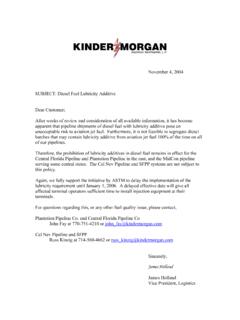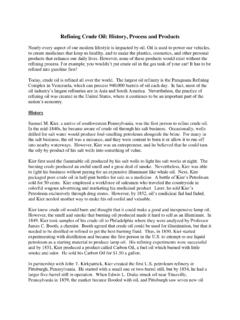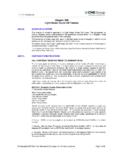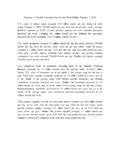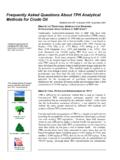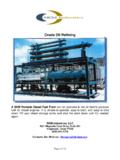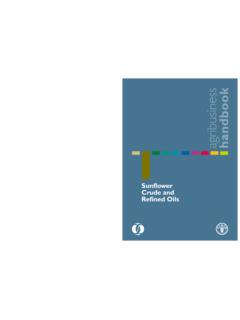Transcription of GAUGING MANUAL - Kinder Morgan
1 1 GAUGING MANUAL 2 Table of Contents GAUGERS SUMMARY 4 PRE-DEPARTURE CHECKS 4 PROCEDURE FOR GAUGING TANKS 6 REFUSING A TANK 12 OIL REFUSAL POLICY 12 TANK TEMPERATURE 13 THERMOMETER INSPECTION 13 LARGE TANKS 13 SMALL TANKS 14 TANK SAMPLING 15 SAMPLING DEPTHS 15 SAMPLING THE TANK 16 Upper Sample 16 Middle Sample 17 Outlet Sample 20 GAUGING 23 OPENING GAUGE 23 CLOSING GAUGE 24 QUALITY TESTING 25 PARAFFIN crude 28 DEMULSIFIERS 28 PUMP OPERATION 29 TIMER OPERATING INSTRUCTIONS 30 IMPORTANCE OF TIMERS 30 TIMERS 32 Mechanical Timer: Intermatic Model T1975 32 Digital Timer: Tork Model E201B 33 Triangle Programmed Timers 34 crude NET HANDHELD 36 MAIN HANDHELD PROGRAM QUICK REFERENCE 37 HANDHELD DAILY ROUTINE 53 LEASE LACT METER TICKETS 55 DESTINATIONS FOR HANDHELD TICKETS - MONTANA 56 DESTINATIONS FOR HANDHELD TICKETS - NORTH DAKOTA 57 CLOSING TANKS THAT HAVE NOT PUMPED 58 GENERAL BUSINESS 58 FIRST DAY OF THE MONTH 58 CONTACTS FOR HELP WITH TICKETS 59 3 CHECKING THE BATTERY STATUS 61 CONNECTING TO THE PRINTER 62 EMPLOYEE ACKNOWLEDGEMENT FORM 66 4 Gaugers Summary The term GAUGING is used to describe the process of measuring the height of the crude in a storage tank.
2 As well as other related activities that determine both the quality and quantity of crude in the tank. A gauger s task is to determine both the quality and quantity of crude oil through GAUGING , sampling, and gravity, temperature, and volume determination. Tank GAUGING is an essential element of inventory control, custody transfer, and leak detection operations. Pre-departure Checks When you report to work and before you proceed to a lease, you are responsible for conducting an equipment inspection. It must include the following: All crude oil GAUGING and test equipment is present, clean, operating correctly, and properly stored in designated locations on the unit. The gauger carrying tray contains: "modified 16-inch clear barrel thief woodback thermometer GAUGING tape and bob two clean, 6 cone shaped, 200 milliliter centrifuge tubes tube of "KolorKut" rags UL approved flashlight two 16 ounce plastic bottles The storage boxes must contain: working centrifuge and sample heater two additional clean 6 cone shaped, 200 milliliter centrifuge tubes hydrometers 1 3/8" hydrometer cylinder disk (dial) thermometer supply of clean solvent ample clean rags The 'portable desk' must contain.
3 CrudeNet portable handheld computer printer a supply of perforated ticket stock tank seals black ball point pens sharpened pencils with erasers 5 other forms and scratch pads as backup to the handheld computer, carry a small supply of preprinted (handwritten) crude Run Tickets 6 Procedure for GAUGING Tanks The following diagram illustrates a summary for the procedure of GAUGING a TANK THERMOMETERM idpoint of the column One operation with modified thiefDETERMINE FREE WATER & SEDIMENT LEVELMust be at least 4" less than the tank outlet height Take opening gauge at reference heightRead tank thermometer nearest / FPump crude into the pipelineTake closing gauge at reference point and check reference heightTest samples for % S&W and compute averagePrepare and distribute measurement ticket TAKE UPPER SAMPLEUsed to determine BS+W of the tankTAKE OUTLET SAMPLEUsed to determine BS+W of the tankTAKE MIDDLE SAMPLER ecord observed gravity and temperature using thermohydrometerAccept or reject the oil 7 Tank GAUGING Summary 1.
4 Be sure the conditions are safe. a. If there is lightning or severe thunderstorms approaching or already in the area, wait until the weather improves and you consider it safe to proceed. b. Make sure the ladders and catwalk are safe. 2. When you arrive at the lease site, check that you: a. are at the right lease location b. know from which tanks you are authorized to remove crude Compare the numbers painted on the tanks with the numbers on the Gauger's Description Sheet or Listing. If you have any doubt, contact your scheduler for additional information before you begin to transport the crude . 3. Walk around the tanks and thoroughly inspect the facility and all connecting pipelines for crude leaks. Check the valves on the overflow lines, transfer lines and draw-off lines.
5 Be sure all valves are closed tightly. Exception: It may be a producer s practice to leave equalizer valves open. Hiland crude does not change the position of the equalizer valves. 4. Be sure that the valve on the incoming flow line to the tank is closed, and additionally sealed if this is a local practice. The producer's representative must close this valve. Exception: Prior arrangements may exist between Hiland crude and the producer to close the valve and gather the crude . Your supervisor will notify you of these prior arrangements. If the valve is not closed and no prior arrangements exist, do not pick up the crude oil. 5. Proceed to the gauger's platform on top of the tank. Ground yourself as you climb the tank by running your hand along the ladder's hand rail as you ascend.
6 6. Standing upwind, open the tank gauge access hatch cautiously and observe the oil surface (use the flashlight if necessary). If H2S is present, wear an approved breathing apparatus and follow all Hiland safety procedures. If the oil is boiling or foaming (not stilled), or if this action occurs when the plumb bob breaks the surface of the oil, the tank has been filled or circulated recently. Do not gather the oil until the tank surface is clean. Exception: The oil may be gathered under Hiland Rules and Regulations, FERC Item 70 and subsequent versions thereof. If this is done, mark GREEN OIL in the remarks section. 7. Lower the woodback (cup-case) thermometer on a cotton cord through the tank's thief hatch, holding the thermometer at least 12 inches from the side of the tank shell to the midpoint of the oil volume to be gathered.
7 To expedite temperature equilibration, raise and lower the thermometer through a distance of 2 feet for 2 minutes. Tie off and leave the thermometer in the tank for a minimum of five minutes. See Tank 8 Temperature section on page 13 for more information. 8. Hiland crude follows the "column of oil" gathering concept. This means that you run (work) the stilled oil in the tank sequentially from the oil surface downward during the sampling and GAUGING process. 9. Take an upper sample from the middle of the upper one-third of the tank contents using a bottom closure modified clear barrel thief. Transfer the upper sample into a 16 ounce plastic bottle by pouring the crude oil through the modified thief's #2 spigot valve. Secure the cap on the plastic bottle and place it in the gauger's tray for later testing.
8 See Tank Sampling Procedures on page 15 for more information. 10. Take a middle sample from the mid-point of the middle third of the tank contents. a. Hang the thief on the inside of the gauge hatch to test the sample. b. Insert a thermo hydrometer into the thief. Determine the temperature and API gravity of the oil and record the readings. See Tank Sampling Procedures on page 16 for more information. c. Pour remaining liquid back into the tank. 11. Use a modified thief to take the outlet and crude merchantability samples simultaneously. Extend the trip rod 4 inches which is commonly used for a twelve inch outlet only, anything greater or less than twelve inches must be compensated accordingly. Lower the thief to the tank bottom.
9 Collect a combined outlet clearance sample. To determine if the tank's water bottom height satisfies the merchantability conditions, remove from the tank and position the thief, now filled with the outlet sample, between a good light source and a level line of sight. Examine the contents to locate the free water and sediment height tank level. The total height is the sum of the distance where the "cut" line crosses the thief's linear scale plus the amount the thief's tension rod is out. Transfer the outlet sample to a second 16 ounce plastic bottle by pouring the crude oil through the thief's #2 spigot valve. Secure the cap on the plastic bottle and place it in the gauger's tray. Note: If the free water and sediment height tank level cannot be seen clearly in the modified thief, hook the thief containing the outlet sample to the inside of the tank access hatch lip and proceed to read the opening gauge.
10 At the same time you read this gauge, verify the tank's water bottom height using water finding paste. See Tank GAUGING section on page 23 for more information. 12. Take the opening gauge. a. If necessary, prepare the gauge tape by coating the tape bob with water finding paste. Place a small amount of water finding paste from the tip of the gauge tape upward over the tape swivel to about the 12 inch mark on the tape. 9 b. Carefully lower the bob, insuring that the gauge tape stays in contact with the access hatch lip during lowering to prevent sparking as the bob enters the fluid. c. During this process, the tape and bob must not deviate from the vertical when reaching the tank bottom or datum plane.




